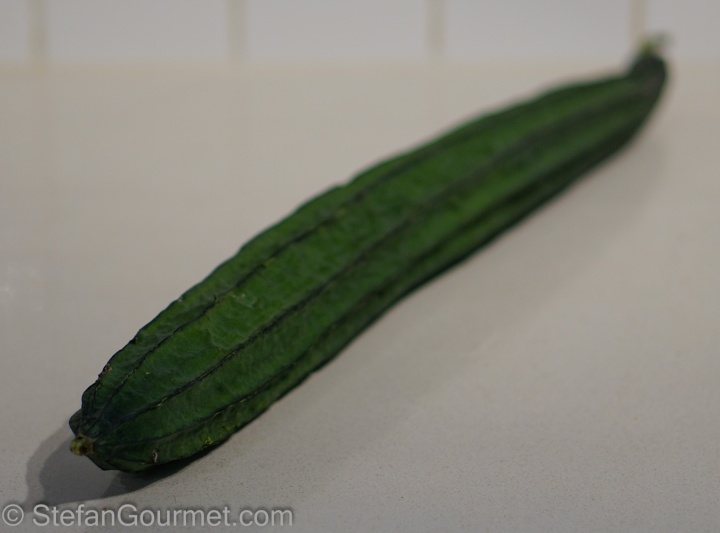
I was feeling adventurous at the Asian market and bought this vegetable that I had never seen or heard of before. It looked like a cucumber with ridges and the sign said “terroi”. When I googled that on my phone, I got no hits whatsoever. As I was feeling adventurous, I bought it anyway and asked a salesperson how to prepare it. She told me in soup or stir fried. Then on the receipt it was listed as “Terroi / Sie kwa”, and that second name was the key to finding out that this is called “angled loofah” (or “luffa”) and is indeed eaten stir-fried or in soups in Chinese cuisine. I only knew the word “loofah” as a cleaning sponge, but the unripe version of the fruit is apparently eaten all over Asia. According to Wikipedia, other English names for it are “Chinese okra, dish cloth gourd, ridged gourd, sponge gourd, vegetable gourd, strainer vine, ribbed loofah, silky gourd, ridged gourd, silk gourd”. In Hindi it is called “torai” or “turai”, so that is most likely why it was listed as “terroi” at the Chinese market.
In Thai it is called “buap liyam” or “buap liam”, and I decided to prepare it stir fried as I think a Thai might do it. (Miranti, please feel free to comment.) Loofah is very good at picking up other flavors such as garlic, chili pepper, soy sauce, and fish sauce. It has a slightly sweet flavor and a crunchy texture on the outside while the inner part is more tender. It worked very nicely with the lime leaf chiffonade. I really enjoyed it and will definitely prepare it again. Here’s what I did.
Ingredients
1 angled loofah (about 500 grams/1.1 lbs)
1 Tbsp minced garlic
1 Tbsp minced chili pepper (or to taste)
1 Tbsp lime leaf chiffonade
2 Tbsp vegetable oil
2 Tbsp soy sauce
2 Tbsp fish sauce
Preparation
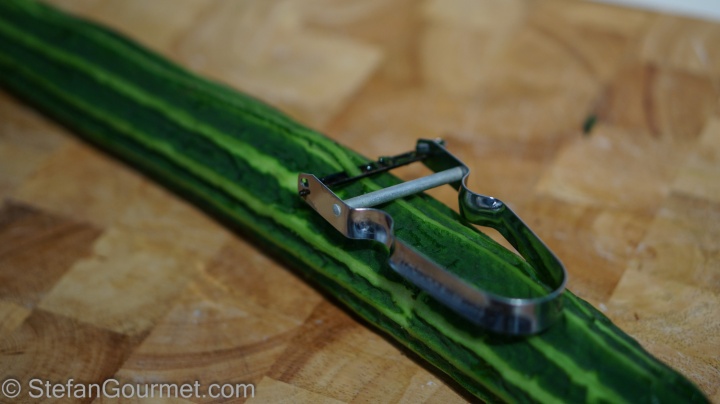
Remove the tough ridges with a knife or peeler. You could also remove the skin altogether, but it adds color and crunchiness so I left it on.
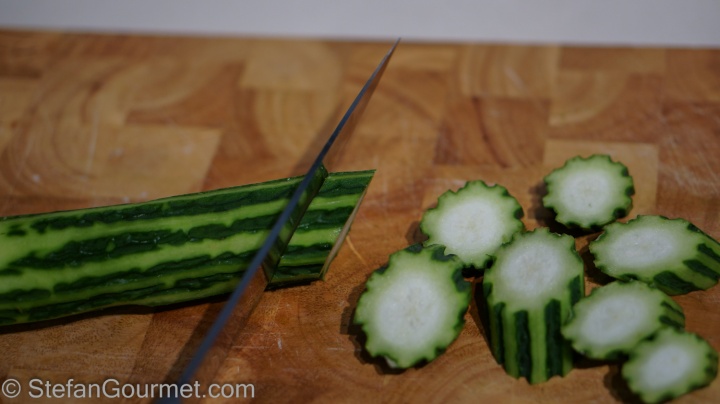
Slice the loofah in 1 cm (1/2 inch) slices.
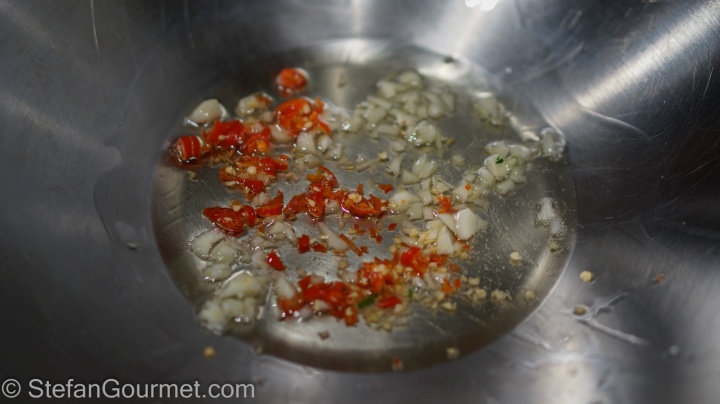
Heat the oil in a wok. Add the garlic and chili pepper and stir fry for a minute.
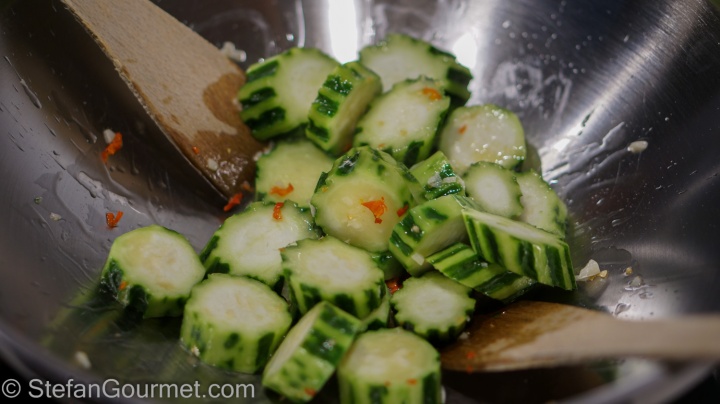
Add the sliced loofah and stir fry for a couple of minutes.
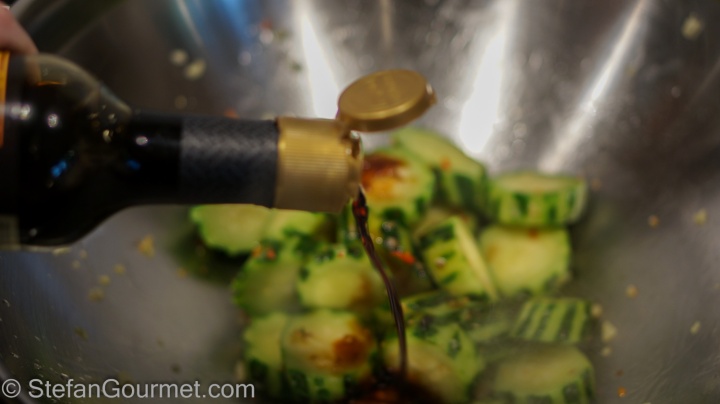
Add the soy sauce, and stir fry for another couple of minutes. If it becomes too dry and starts to stick to the wok, add a tablespoon of water if needed.
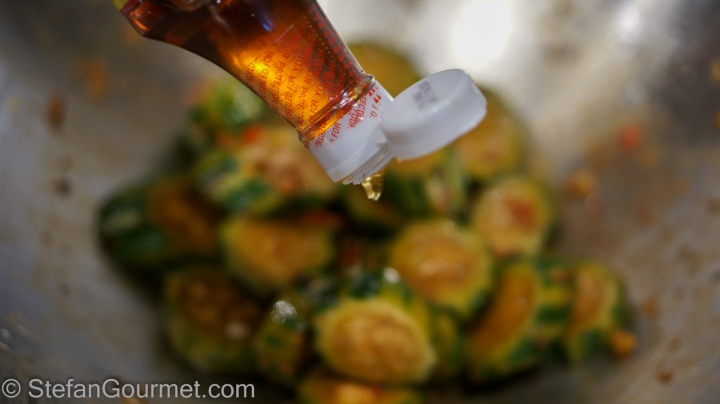
When the loofah is tender on the inside, turn off the heat and add the fish sauce.
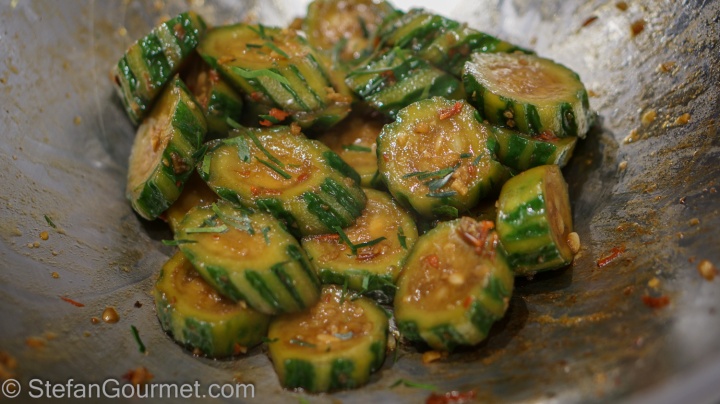
Add most of the lime leaf chiffonade and stir to incorporate.
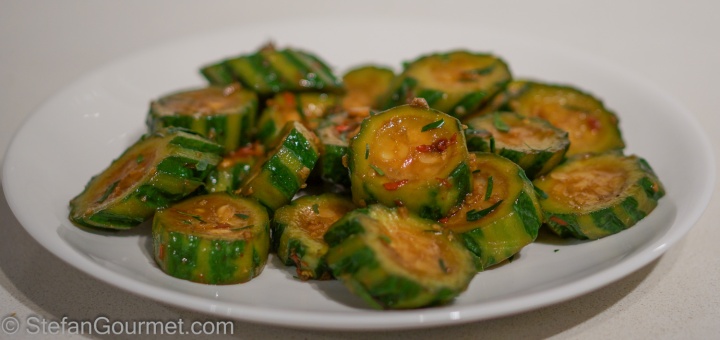
Serve immediately, sprinkled with the remaining lime leaf chiffonade.
Flashback
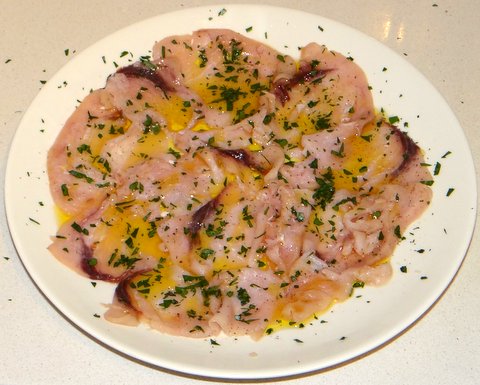
If you can get fresh (or good quality frozen) swordfish, a great way to serve it is as swordfish carpaccio.
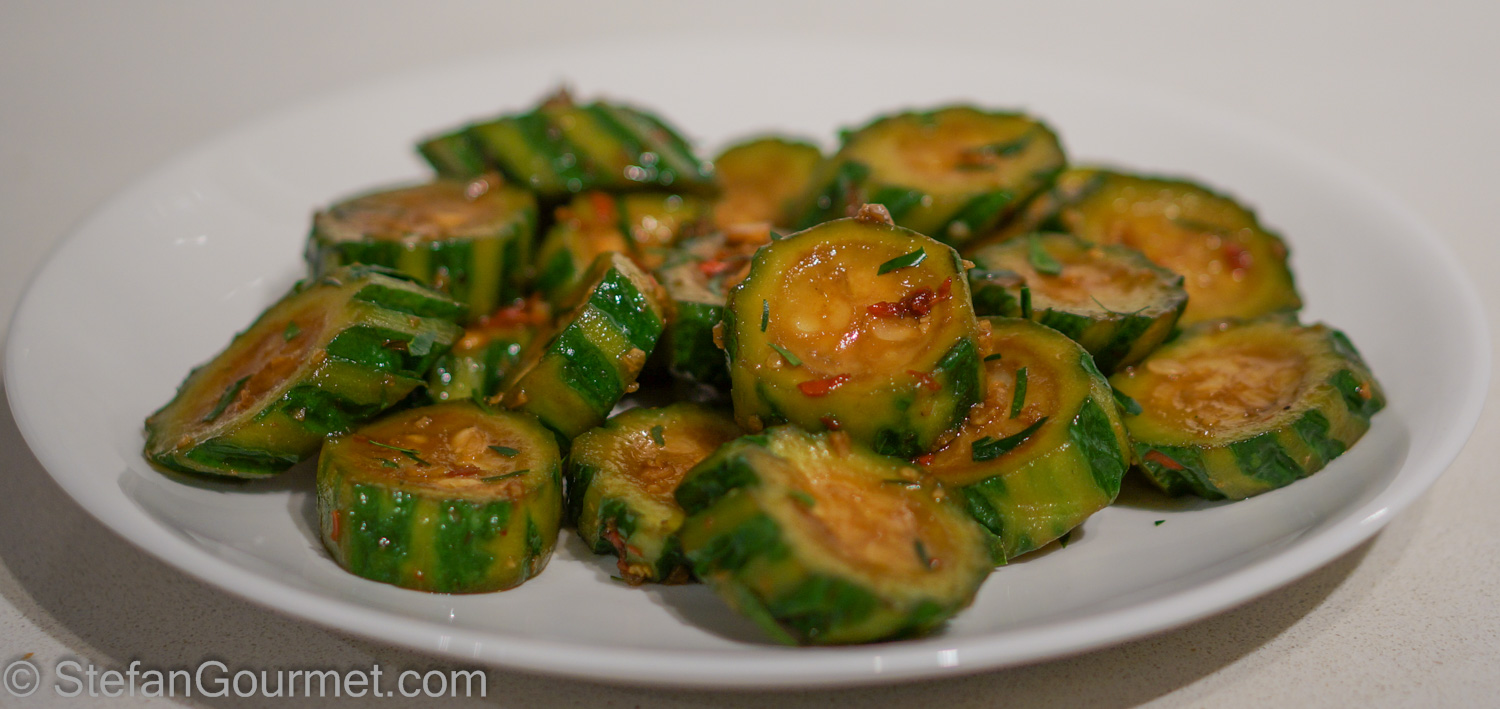
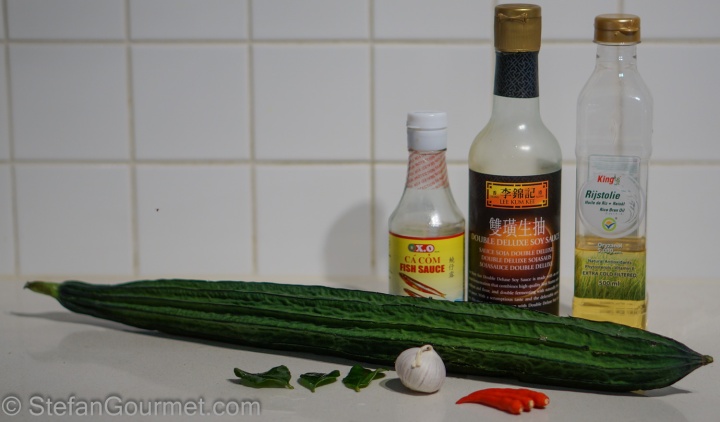

You are definitely adventurous! But it looks really good!
LikeLike
It was! I have no idea how common this vegetable is in the US.
LikeLike
Thanks for this.. I live so close to a lot of asian grocery stores and definitely will stop in and try this recipe. 🙂
LikeLike
Great, let me know how it turns out!
LikeLiked by 1 person
My only thing is the fish sauce… I don’t really want anything but fish to taste fishy. Any recommendations for substitutions?
LikeLike
The fish sauce adds umami and saltiness. I guess oyster sauce is out too, so then I’d say substitute with more soy sauce or a bit of salt.
LikeLiked by 1 person
but does either have that “fishy” taste?
LikeLike
If fish sauce (or oyster sauce) is used in moderation, to my taste it adds umami and saltiness without a ‘fishy’ taste. It should be such an amount that you don’t really taste it as an individual taste, but just as a flavor enhancer. If you still don’t like it, stick with soy sauce.
LikeLiked by 1 person
Alright, I will. I heard something recently about Umami… isn’t it a flavor of itself? (lol I just googled it, yes, I guess it is) Well I thank you, and I’ll let you know how it goes. 🙂
LikeLike
Umami is indeed a flavor of itself. It has a Japanese name because it was discovered by a Japanese guy. Umami is in stuff like parmesan cheese, tomatoes, mushrooms, anchovies, soy sauce, fish sauce, etc. It makes food more ‘flavorful’.
LikeLiked by 1 person
Well I was all wrong about fish sauce I guess! Thanks 🙂
LikeLike
This vegetable is called Turai in Hindi. Google that and you will find loads of recipes. 🙂 It is a pity that you discarded the peel; it is used to make a fabulous chutney. You can find a couple of recipes on my blog with Turai. Search for Beerakaya as that is what it is called in Telugu. 🙂
LikeLike
Thanks, I’ll check it out. I’ve never yet tried to cook Indian food.
LikeLike
Well I have always thoughtlLoofah was a shower sponge too. Who knew? I have personally never seen this in the store in my small town in the U.S.. Results may vary I guess if you live in a big city. I’m sure it was delicious, it sure looks great!
LikeLike
I’m glad I’m not the only one who was ignorant about loofah as a vegetable.
LikeLiked by 1 person
I had to take a look to see how you cooked a bath sponge (yes that’s what I thought it was too, I was half hoping to see a sponge in the sous vide machine) but now I’ve seen it, it does look like giant okra. Well a bit anyway…
LikeLike
Sponge in the sous-vide machine… LOL!
LikeLike
I’ve never come across a loofah before, but this looks divine, especially with a swordfish carpaccio. What a treat!
LikeLike
Thanks! I wouldn’t serve the stir-fried loofah together with the swordfish carpaccio — I just include links to posts from two years ago to give them a second life.
LikeLike
Indeed this vegetable is great in soup, a clear broth Chinese soup. It tastes great as you say, slightly sweet flavour and unpeeled will help retain some bite to the overall texture…
LikeLiked by 1 person
An adventure I’ll sign up for. Love the chili flakes… A beautiful and vibrant exploration.
LikeLiked by 1 person
I love the “Buab Liam” (Buab = Gourd, Liam = sharp corner). I would stir fry with garlic, ground pork, fish sauce, granulated sugar and either egg or cornstarch. Then top it off with a lot of white pepper. The way you did is ok too. I just can’t eat chilli.
There is a way to check if the Buab Liam is young (the old one would be very tough). You just use your finger nail prick the skin. If it pierce through the skin, it’s edible. If not, don’t buy.
LikeLike
Thanks, Miranti. Glad that you approve 😉 Next time I will try your recipe.
LikeLike
Looks tasty!
LikeLiked by 1 person
Nice looking dish, Stefan. have seen this at the Asian markets in the area but never tried it. i guess I should. 😉
LikeLike
You should indeed, because it works well with chiles 😉
LikeLiked by 1 person
I’m in Asian markets often, Stefan, and have seen these which-a-ma-callits very often. Unlike you, though, I haven’t the nerve to pick one up and bring it home. Your preparation sounds great and I like that you only partially removed the skin. It adds interest to the final dish, as well as the crunch you mentioned.
LikeLiked by 1 person